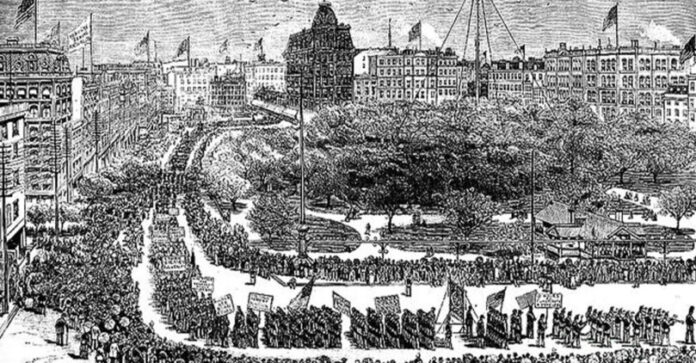
By Sam Judy, Dallas Weekly News
Reflecting on the 129th Labor Day brings significance to the larger meaning behind the holiday. While the world looks different from the first day commemorating the nation’s workers, the United States still values property and profits over individuals. Black-led movements have always contended for the greater valuation of human life and, likewise, have been a driving influence within the labor movement.
The year 2023 has been a big year for the labor movement in the US. At the end of last year, President Biden signed a bill to block the then-impending national rail strike that was partially motivated by stricter time regulations leading to worse safety standards. The following train derailment in East Palestine, Ohio in February dominated the news cycle and was one of many derailments that occurred across the country following Congress’ measure against the strike.
Consequently, the year has been filled with a thick tension between workers and the ruling class, as it has become apparent that in advocating for greater safety measures and for the overall health of the nation through direct and indirect links. Aside from deeper theory and direct action, the labor movement is built on the principle that value is derived chiefly from workers. A worker unpaid their fair share in accordance with the capital they generate is exploitation.
In the American gamut of exploitation, the nation’s highest crime is slavery. Famously, civil rights activist W.E.B. DuBois referred to the Civil War as a general strike, noting that hundreds of thousands enslaved people ceased work, as some joined the Union Army. As the Emancipation Proclamation jump-started a large-scale Black labor movement – with some essentially on strike as others took up arms in fighting the Confederate forces defending the institution of slavery – the narrative of slavery’s abolition is rarely contextualized as vital to the larger labor movement despite a non-theoretical connection.
Slavery represents unchecked power held by the country’s economic elite, a full ownership of working bodies to the point of institutionally led dehumanization. It exhibits the sad truth that while freedom has been withheld from marginalized people, there has always been a free market in the United States. Many slaveholders defended the implementation of slavery as an economic right, in the same way that government and corporate leaders have defended outsourcing work to countries with lower standards of treatment. In this sense that the freedom of the market has always eclipsed the freedom of the individual.
While solidarity with white workers brought Black workers onto the union stage, such as during the Great Strike of 1877, by 1894 the movement was fractured among poor whites and the new generation of freed Black folk. Due to exclusion from unions, such as Eugene V. Debs’ American Railway Union, Black workers were hired as strikebreakers by companies such as the Pullman Company. America’s first recognized Black-led labor union came in the form of the Brotherhood of Sleeping Car Porters (BSCP) in 1925.
Led by Asa Phillip Randolph, the group advocated for the rights of more than 18,000 Black railway workers of the Pullman Company to combat racialized exploitation. After 12 years of work, Randolph established a contract with the Pullman Company, offering unprecedented benefits for the BSCP.
Despite previously acting as another obstacle to the advancement of Black people in the United States, the organized labor movement established itself as an ally to the civil rights movement. With over 400,000 Black union members by the early 1940s, the civil rights movement had successfully integrated with the labor movement. During World War II, Black Americans segregated within the armed forces and were largely excluded from the economic fortune enjoyed by white workers in defense and military production. Accordingly, Randolph organized for 10,000 Black Americans to march on Washington, D.C. in what was considered one of the most militant and important displays of Black solidarity in history at the time.
Eventually pushing then-President Franklin Roosevelt to sign Executive Order 8802, effectively banning “discrimination in the employment of workers in defense industries or government because of race, creed, color, or national origins,” Randolph’s efforts led to direct transformative change for the Black community of the United States.
The Fair Employment Practice Committee (FEPC), the committee established in the wake of Executive Order 8802 to collect information and investigate complaints, was dissolved before the war was over. While Randolph failed in salvaging the committee, lobbying congress but failing to keep it operational, his work laid the political groundwork for the labor movement to cross a racial divide. Eventually, with the passage of the Civil Rights Act of 1964, discrimination in workplaces and among labor unions was outlawed.
As leaders like Fred Hampton, Malcolm X, Angela Davis, and Martin Luther King Jr. all embraced the ideals of leftism during the most transformative years of the civil rights movement, politics centered on the working class was key in the progression of a revolutionary mindset. The labor movement of the United States has incrementally afforded rights to the working class in tandem with accomplishments in social justice.
The United States is currently in the midst of its own resurgence in the modern labor movement. At the cross-section between labor sectors including transportation, defense manufacturing, arts & entertainment, and the medical field, consequential strike efforts have emerged in the midst of a devastating bout of inflation in the aftermath of a pandemic lockdown. Labor Day commemorates not only our workers, but also their revolutionary spirit which defends their humanity in a capitalist system.


